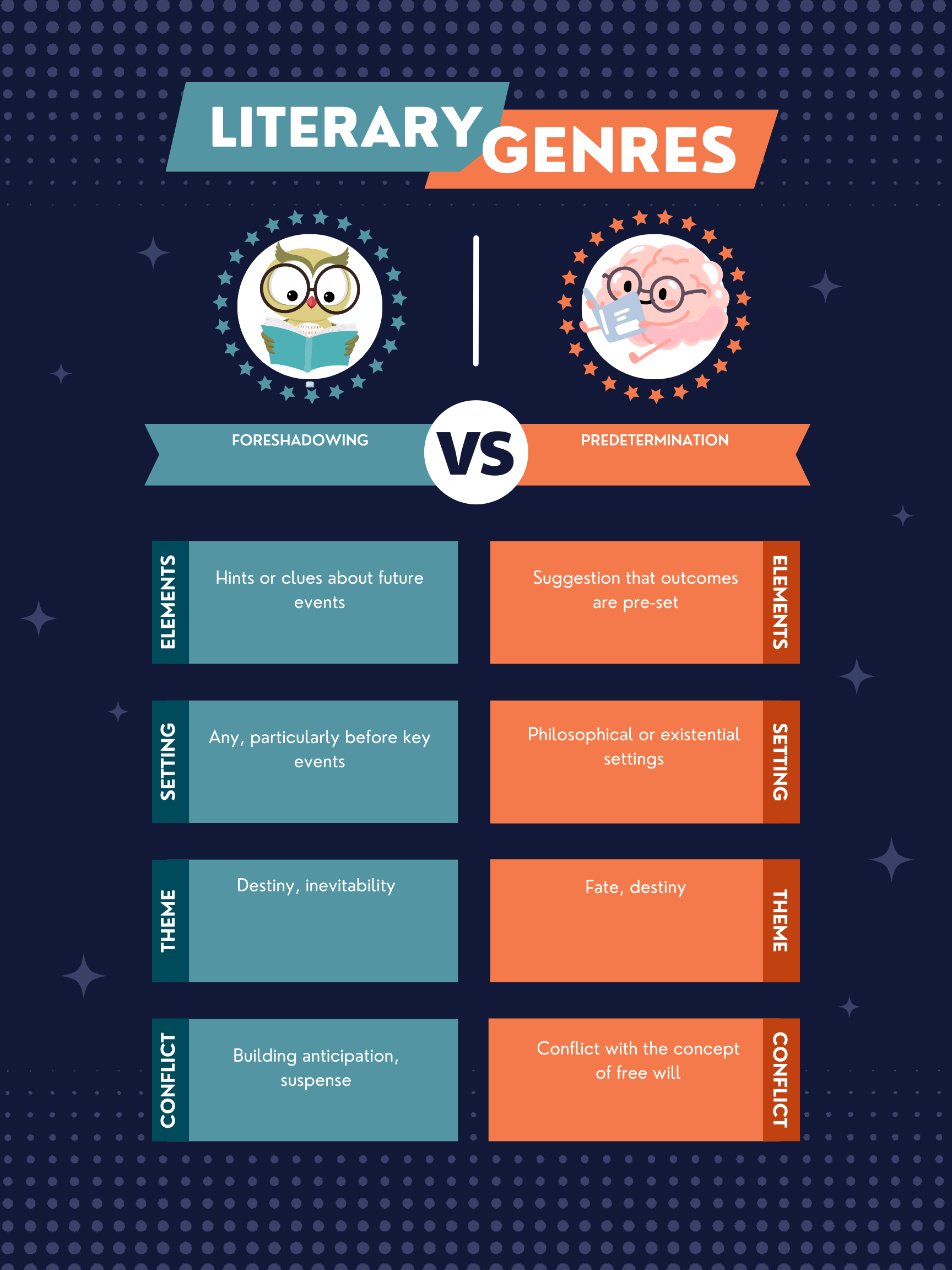Foreshadowing hints at future events or outcomes in a subtle way, suggesting what might come without revealing the story; Predetermination implies that events are fixed in advance, often related to fate or destiny themes.
Foreshadowing
Foreshadowing is a literary device used by authors to provide hints or clues about what will happen later in the story. It creates anticipation in the reader’s mind, preparing them for what is to come without explicitly revealing the plot.
Example: In The Great Gatsby by F. Scott Fitzgerald, the billboard of Dr. T.J. Eckleburg’s eyes foreshadows the theme of the decline of the American Dream and the moral decay of society.
Predetermination
Predetermination in literature refers to the concept that the course of events in the story is predestined by fate or a higher power. Characters may struggle against this destiny, but their efforts are often in vain, emphasizing themes of fate, destiny, and the limitations of human agency.
Example: In Shakespeare’s Macbeth, the witches prophesy Macbeth’s rise to power and subsequent downfall, suggesting that his fate is sealed from the beginning, regardless of his actions.
Summary
| Literary Device | Definition | Purpose | Usage | Relevant Examples |
|---|---|---|---|---|
| Foreshadowing | Hints or clues about what will happen later in the story. | To build anticipation and prepare readers for future events. | Used subtly throughout the narrative to enhance suspense and thematic depth. | The Great Gatsby by F. Scott Fitzgerald. |
| Predetermination | The concept that events are fixed in advance by fate or destiny. | To explore themes related to fate, destiny, and human limitations. | Often used in stories dealing with the struggle against fate or in narratives emphasizing the inevitability of certain outcomes. | Shakespeare’s Macbeth. |
Writing Tips
For writers aiming to weave Foreshadowing or Predetermination into their narratives, consider these tips:
- Foreshadowing: Distribute hints throughout your story that are subtle enough not to give away the plot but clear enough to be recognized in hindsight. Consider using symbols, dialogue, or setting elements as foreshadowing tools.
- Predetermination: Develop your story in such a way that the predetermined events feel integral to your characters’ journeys. While exploring fate or destiny, ponder the role of free will within your narrative and how it interacts with these themes.
FAQs
How do Foreshadowing and Predetermination differ in their impact on a story?
Foreshadowing serves to enhance the reader’s anticipation and engagement with the unfolding story, while Predetermination focuses on thematic exploration of fate, destiny, and human agency, often giving the narrative a sense of inevitability.
Can Foreshadowing and Predetermination be used together in a story?
Yes, they can complement each other effectively. Foreshadowing can hint at the predetermined events that are to unfold, adding layers of depth and complexity to the narrative.
How can I effectively use Predetermination without making my story predictable?
Focus on the characters’ reactions to their fates and the choices they make along the way. This can add unpredictability and richness to a narrative that revolves around predetermined events.
Exercise
Decide whether the following examples showcase Foreshadowing or Predetermination:
- A novel opens with a dream sequence where the protagonist sees themselves standing at a crossroads, symbolizing the crucial choices they will face.
- In a fantasy story, a prophecy is revealed stating that the chosen one will rise to defeat the dark force, but not without great sacrifice.
Answers:
- Foreshadowing.
- Predetermination.
Other Device Comparisons You May Find Interesting
- Symbolism vs Metaphor: Dive into how these devices convey deeper meanings in different ways.
- Irony vs Sarcasm: Unpack the subtleties that differentiate these often-confused rhetorical devices.
- Allusion vs Allegory: Explore the distinction between direct and indirect references and their narrative impacts.
- Narrative Perspective vs Point of View: Understand how the narrative stance affects storytelling and reader engagement.
This guide aims to shed light on the intriguing roles that Foreshadowing and Predetermination play in literature, enriching narratives and engaging readers with thoughtful complexity. 📘✨

